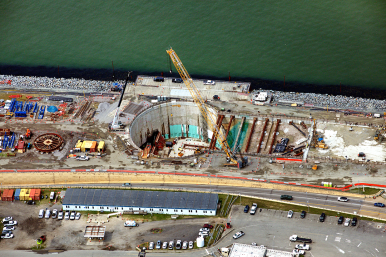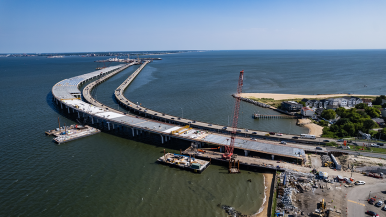Light at the end of the tunnel
Bridge-tunnel expansion is key to Hampton Roads’ growth
Beth JoJack //October 30, 2023//

The $3.9 billion Hampton Roads Bridge-Tunnel expansion project is “the largest transportation project that the commonwealth has ever had,” says HNTB Associate Vice President Ryan Banas, project director for the expansion. Photo by Mark Rhodes

The $3.9 billion Hampton Roads Bridge-Tunnel expansion project is “the largest transportation project that the commonwealth has ever had,” says HNTB Associate Vice President Ryan Banas, project director for the expansion. Photo by Mark Rhodes
Light at the end of the tunnel
Bridge-tunnel expansion is key to Hampton Roads’ growth
Beth JoJack //October 30, 2023//
Off and on since the 1980s, John Rivera has commuted from his home in Hampton to Naval Station Norfolk.
He’s seen Interstate 64 grow from two to four lanes in the region, but these days, Rivera, a ship maintenance manager for the U.S. Navy, mainly sees lots of traffic jams caused by the $3.9 billion Hampton Roads Bridge-Tunnel (HRBT) expansion project, for which construction began in November 2020.
To avoid the worst of the congestion, Rivera hustles to reach the HRBT before 6 a.m., and he negotiated a hybrid work plan with his manager so that he can leave each day in time to get back to the tunnel before 2 p.m.
While expansion construction has made his commute trickier, Rivera allows that his day-to-day existence will be improved if the expansion decreases congestion on the HRBT. “Traffic affects our work-life balance,” he says.
The hope is that the expansion will improve quality of life for millions of people living in and traveling through the Hampton Roads region. During the summer tourism season, as many as 100,000 vehicles per day traverse the HRBT, according to the Virginia Department of Transportation.
In addition to reducing traffic congestion, the expansion will create more lanes for hurricane evacuation and is expected to improve access to the Port of Virginia’s marine terminals and Naval Station Norfolk, the world’s largest naval station.
Getting it done, however, is a massive endeavor.
It includes the construction of twin, two-lane tunnels, expanding the HRBT to eight lanes underwater. The project also includes widening about a 10-mile stretch of Interstate 64.
Often, the biggest construction projects in the United States are broken into multiple smaller projects, points out Ryan Banas, project director for the expansion.
“One of the things that makes us truly unique is that we are a single $3.9 billion construction project,” says Banas. “So, looking at it from that perspective, we are one of the largest [construction projects] in the country. We are the largest project that VDOT has ever performed and the largest transportation project that the commonwealth has ever had.”
Banas is an associate vice president for HNTB, which is providing engineering services and project management for the expansion. The construction contractor for the project is Hampton Roads Connector Partners, a joint venture led by Dragados USA that includes Vinci Construction, Flatiron Construction and Dodin Campenon Bernard.
VDOT still lists November 2025 as the contracted completion date for the expansion, but Banas allows that work has taken longer than planned. “We’re running a little bit more than a year behind schedule,” he says, chalking the delay up to “the complexity of a project of this magnitude.”

In September, VDOT staff asked the Commonwealth Transportation Board for a 600-day extension on the project, and the board voted in favor of allowing the state highway commissioner to change the project agreement.
Progress on the HRBT expansion is an ever-popular topic for Hampton Roads residents and leaders, says Bryan Stephens, president and CEO of the Hampton Roads Chamber of Commerce.
“There’s a great deal of interest in the project and its timeline and its completion because I think they understand the importance of it to our economy here,” Stephens says.
Reducing congestion on the HRBT is key to the region’s economic health, says Doug Smith, president and CEO of the Hampton Roads Alliance, a regional economic development organization. “That connection between the south side of the peninsula is critically important for cargo, is critically important for tourism, [and] it is critically important for commuters,” he says. “And so, to be able to solve that congestion … for the coming decades is a really important project for the growth of the region.”
Hampton Roads’ economy, Stephens points out, is supported by three pillars: the Department of Defense, the Port of Virginia and tourism. The HRBT expansion, he says, is badly needed for all three pillars to remain healthy.
“All three of those rely on an effective and efficient multimodal transportation system,” Stephens says.
Mary’s big dig
The HRBT expansion work that’s most noticeable to drivers revolves around the widening of I-64.
“On the Mallory Street Bridge, crews finished girder erection and will soon begin constructing the deck spans on the southern half of this new bridge,” says Brooke Grow, VDOT communications manager for the HRBT expansion project. “Motorists may have also noticed many drainage improvements and widening activities occurring in the median of I-64 East/West that will begin to accommodate two additional travel lanes in each direction over the coming months.”
Workers also continue to check off project milestones.
As early as winter 2024, VDOT anticipates traffic on I-64 east from Hampton may switch from a temporary marine bridge constructed for the expansion to the new permanent marine bridge, according to Grow.
The biggest bit of progress on the expansion in recent months came in late April when a $70 million, custom-built tunnel boring machine (TBM) launched from South Island, one of two artificial islands created for the HRBT prior to its 1957 opening.
The TBM will dig an 8,000-foot-long tunnel to North Island, the other man-made island that’s located closer to Hampton, before turning around and digging another tunnel back to South Island.
“I will tell you, the day Mary breaks through, that’ll be a huge celebration for the project team,” Banas says.
In 2021, VDOT announced students from St. Gregory the Great Catholic School in Virginia Beach had suggested the winning entry in a contest to name the TBM. The students picked the name Mary after Mary Winston Jackson, the late Hampton-born, Black mathematician and aerospace engineer at NASA, who was a subject of the Academy Award-nominated 2016 film “Hidden Figures.”
German TBM manufacturer Herrenknecht AG built Mary over 14 months. At 46 feet in diameter and 430 feet long, it’s the second largest TBM ever used in North America and the largest TBM of its type, according to Banas. “It’s very easy to get awestruck looking at it,” he says.
It took four months and three vessels to transport Mary to Virginia, according to VDOT. Once here, workers reassembled the TBM in a specially designed pit on South Island, an endeavor that took another six months.
On April 24, Mary went to work. Its 46-foot cutterhead relies on 198 scrapers and 26 disc cutters to scoop soil, according to VDOT.

Mary also has another job: installing the tunnel’s lining.
Workers for Alexandria-based Technopref Industries build 15-foot-wide segments out of precast concrete at a facility in Cape Charles. It takes nine segments to connect into one ring, which make up the tunnel’s lining, according to VDOT. More than 21,000 segments will be needed to complete the two tunnels.
From Cape Charles, the segments are transported via barge down the Chesapeake Bay to South Island. A crane transports the segments to the TBM, which has a vacuum erector capable of precisely fitting the segmented rings into place.
As of late September, Mary had installed 244 rings and had mined nearly 1,700 feet beneath Hampton Roads harbor, according to Grow. “The entire machine is underground,” Banas says. “You can see the tunnel liner taking shape behind it.”
Mary couldn’t do its work without Katherine, the slurry treatment plant, which is named for the late Katherine Johnson, another mathematician at NASA who was played by Taraji P. Henson in “Hidden Figures.”
Slurry, a mixture of bentonite clay and water, provides a counterpressure that allows Mary to dig, according to VDOT. Slurry and debris produced by Mary’s tunnel digs are transported through 22-inch pipes to Katherine. Once the excavated material reaches Katherine, technicians monitor the process to check for anomalies.
In early September, three TBM operators were running Mary five days a week, 24 hours a day, according to Banas. Each TBM operator hails from outside North America — “just because that experience doesn’t reside here in the U.S. yet,” he says.
During their shifts, Banas explains, the operators sit in a 6-by-12-foot room with “an array of monitors and sensors in front of them that allow them to control the machine directly from their station.”
They also have plenty of folks looking over their shoulders.
“We have 100% ability to remotely monitor anything that’s going on in the machine,” Banas says. “Our contractor can … have other experts look at the data in real time and also have recordings to go back and understand how the machine is behaving.”
VDOT can do the same thing.
“We have experts that VDOT has brought in that … ensure that these machines are operating in a manner that ensures their longevity throughout their journey,” Banas explains.
Turnaround time
Workers have completed excavating a 65-foot-deep receiving pit on the North Island, according to Grow. This will be Mary’s resting spot after the TBM completes the first tunnel.
As of late September, workers were hand-tying steel rebar that will later support a 5,400-cubic-yard concrete base slab for Mary. Pouring the concrete for the slab, which was scheduled to take place in mid-October, was estimated to take about 36 continuous hours, requiring 600 concrete trucks.
“As far as we’ve been able to determine, it is the largest concrete pour in VDOT’s history and we well believe it may be one of the largest pours in the commonwealth’s history,” Banas says.
If work continues to progress at the current pace, Banas expects that they’ll begin the process of turning Mary around to dig the second tunnel by fall 2024.
“It’s going to take us between about four and five months to do that full rotation,” he says. “Because during that time … Mary will be completely out of the ground. It gives us a great opportunity to go in and inspect all of her surfaces, cutter tools, all the equipment associated with her that we can’t see when she’s actively mining.”
Banas estimates Mary will return to South Island by summer 2025. At that point, he says, Mary will be put out to pasture. The TBM was designed, Banas adds, for the conditions at the HRBT. “We have very unique geology here,” he says.
Some parts of Mary may be sold back to Herrenknecht, but mostly, the TBM will be scrapped. “We are Mary’s one and only engagement,” Banas says.
Like its namesake, Banas says, Mary can take pride in the important role it played in Virginia’s history.
In 100 years, he says, the tunnels Mary is currently digging will likely still be serving their intended purpose. “It’s pretty special,” says Banas.
n














